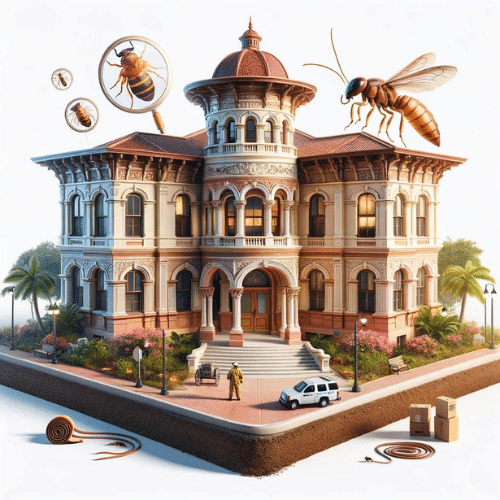
06 Mar Pest Control for Historical Properties
Preserving South Florida’s Historic Legacy
South Florida is home to a wealth of historic buildings, each with its own story to tell. These structures are not only architectural marvels but also carry the rich heritage of the region. Protecting them from the ravages of time and pests is a task that requires expertise and sensitivity.
Historic buildings serve as tangible links to our past, offering insights into the architectural styles, cultural trends, and historical events of bygone eras. They contribute to the unique character of South Florida and are often central to community identity. Preserving these structures is crucial for maintaining the historical continuity and cultural richness of the area.
Unfortunately, historic buildings are particularly vulnerable to pest infestations. Their age, construction materials, and design can make them attractive to a variety of pests, including termites, rodents, and wood-boring beetles. These pests can cause significant damage, undermining the structural integrity of the buildings and eroding their historical value.
Wood Pests in Historic Structures
Termites are notorious for their ability to consume wood, posing a severe threat to the wooden components of historic buildings. They can weaken the structure, leading to costly repairs and restoration efforts.
Rodents, such as rats and mice, not only pose health risks but can also damage wiring, insulation, and other building materials. Their gnawing and nesting habits can lead to further deterioration of the building.
Wood-boring beetles, like powderpost beetles and old house borers, can infest wooden beams and furniture, causing extensive damage over time. Their presence often goes unnoticed until the damage is significant, making early detection and intervention crucial.
Pest Management Challenges
One of the main challenges in pest control for historic buildings is the need to balance effectiveness with preservation. Traditional pest control methods may not be suitable due to the sensitivity of the materials and the desire to maintain the building’s originality.
Regulatory constraints often govern the treatment of historic buildings. Any intervention must comply with preservation standards, ensuring that the building’s historical integrity is maintained.
Accessing and treating infestation sites can be difficult in historic buildings, where hidden voids and intricate designs are common. This complexity requires a tailored approach to pest control.
Preserving the Past with IPM Solutions
IPM offers a comprehensive strategy that focuses on prevention, monitoring, and targeted intervention. By understanding the specific needs of historic buildings, IPM can provide effective pest control while preserving their historical integrity.
Regular inspections are a cornerstone of IPM, allowing for the early detection of pest activity. By identifying potential issues before they escalate, preventive measures can be implemented more effectively.
Preventive measures, such as moisture control, sealing entry points, and proper sanitation, can significantly reduce the likelihood of pest infestations. These proactive steps are essential in safeguarding historic buildings against pests.
Environmental and Maintenance Strategies
Environmental modifications can deter pests from inhabiting historic buildings. For example, ensuring proper drainage and ventilation can reduce moisture, which is a major attractant for many pests.
Maintaining the building’s exterior, such as repairing cracks and gaps, can prevent pests from gaining access. This physical barrier is a crucial line of defense against infestations.
Regular cleaning and maintenance of the interior, including monitoring for signs of pest activity, are vital for early detection and control. A clean and well-maintained environment is less inviting to pests.
Preservation and Pest Control
When faced with a pest infestation in a historic building, professional pest control services are often the best course of action. Experts in historic preservation and pest management can provide tailored solutions that respect the building’s heritage while effectively addressing the pest problem.
Professionals can employ non-invasive techniques and use products that are safe for historic materials. This specialized approach ensures that the building’s historical features are preserved during the treatment process.
Ongoing monitoring and maintenance by professionals can provide lasting protection against pests. Regular check-ups and treatments help prevent future infestations, ensuring the continued preservation of the historic building.
Conclusion
In conclusion, preserving South Florida’s historic buildings is a crucial endeavor that demands careful attention to pest management. The unique challenges posed by pests in these structures necessitate a thoughtful and sensitive approach, balancing effective control with the preservation of historical integrity. Professional pest control services, equipped with the expertise and specialized techniques required for historic preservation, play a vital role in safeguarding these irreplaceable landmarks.
Integrated Pest Management (IPM) stands out as a comprehensive strategy that aligns with the preservation goals of historic buildings. By focusing on prevention, regular monitoring, and targeted interventions, IPM helps maintain the structural and historical integrity of these treasures. Regular inspections and preventive measures are key components of this approach, ensuring that potential infestations are addressed before they can cause significant damage.
Ultimately, the preservation of South Florida’s historic legacy relies on a collaborative effort between property owners, preservationists, and pest control professionals. By embracing proactive and respectful pest management strategies, we can ensure that these historic buildings continue to tell their stories and enrich our communities for generations to come.


No Comments